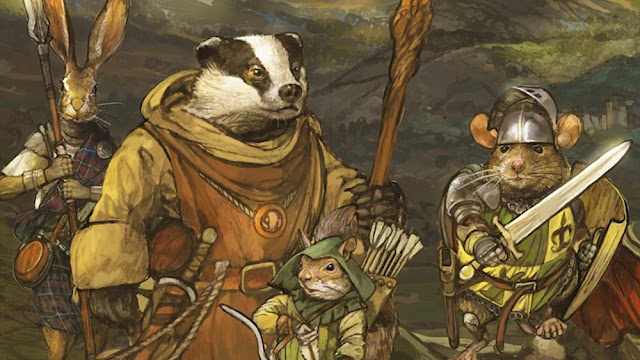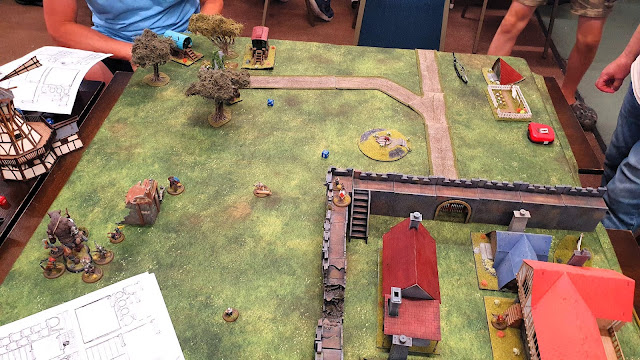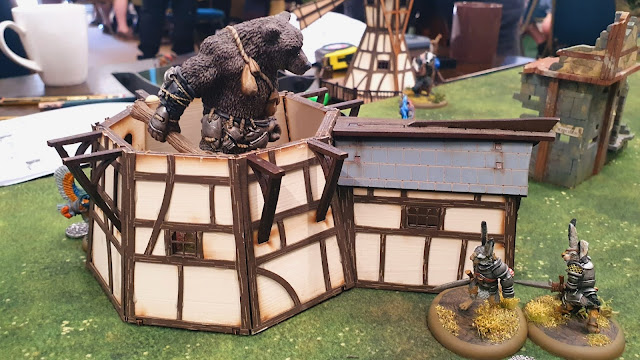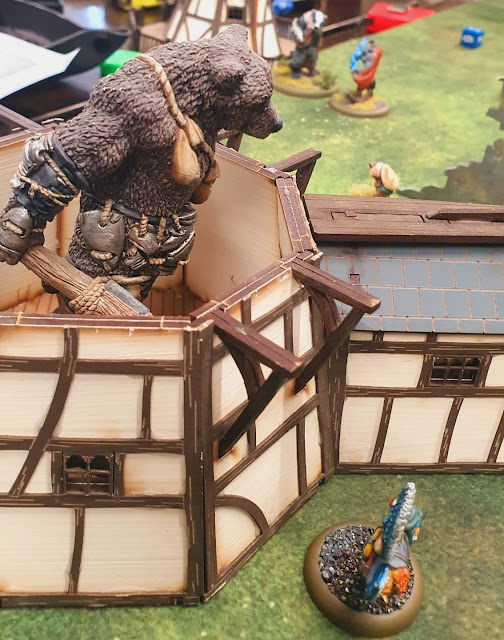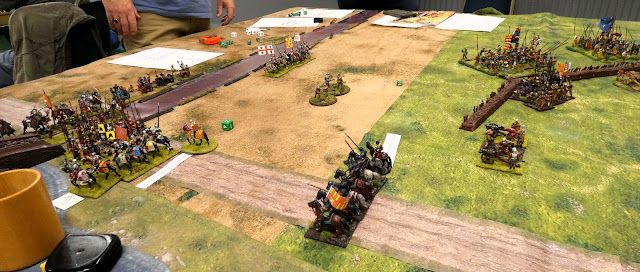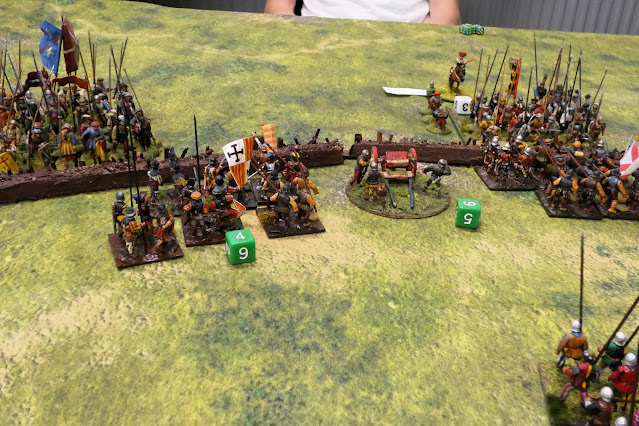At the repeated insistence of our chairman**, I agreed to offer another game of Oathsworn’s Burrows and Badgers at club this month. The game is a small-scale (in model count, not size) skirmish game written by Michael Lovejoy (who also sculpts all the figures), that offers something like a cross between Mordheim and Redwall.
** Editors Note - 'A slight exaggeration!'
 |
| Burrows & Badgers, Second Edition - Osprey |
This was our first outing with the new second edition, and while some elements have been made more complicated (there are more possible Actions than before, every character has two Actions per Turn, Fate points play a bigger and more varied role, the post-game sequence has been extended, etc.), others have been streamlined (most notably Hiding/Searching/Ambush) and some of the synergies more prone to abuse have been tightened up (no more machine-gun crossbows with Haste and Fast Shot, for example, or extremely profitable equipment factories through the Smithy or Jeweller’s Workshop Den Upgrades - not that I imagine these were ever a massive problem: this is not a game for those who prefer competition over narrative).
Overall, it retains the same intuitive structure of play and flavour of the quality dice; if the added complexities have raised the barrier of entry slightly, it nevertheless feels just as comfortable once you get going, and my role as umpire quickly receded into the background as the players got to grips with the mechanics. The whimsical, if quite violent, anthropomorphic animal setting of Northymbra (this month topically transferred to Free Kernow) is still quite special, and a substantial treat of the game is playing with Michael Lovejoy’s beautiful figures (which are also some of the most enjoyable to paint
that I’ve ever done).
Our first match was a straightforward meeting engagement between the Royalist Escanceastre Garrison, under its hare captain, Sir Erembald the Hardy, and and the Rogues of the Haldon Chancers, led by the otter outlaw Alfred Silvertail.
The garrison deployed inside the walls of Escanceastre on one corner of the table, while the Chancers’ camp lay in the opposite corner.
We played a simplified version, without the additional objectives or side quests. The addition of the support quests (taking opponents Out of Action in close combat for the Royalists, successfully Searching terrain for the Rogues), however, were very helpful in encouraging the different factions to behave as they ought.
The Chancers won the Initiative for the first Turn, and started pushing toward the road leading to Escanceastre. The garrison scrambled, with some heading for the main gate, others through a gap in the wall. Galland de Pomeroy, crossbow-hare extraordinaire, bounded up the steps to the parapet, followed closely by Br Muslinus, the mouse monk. Etheldreda Chitterbeak, sparrow, and Pernelle the Flash, kingfisher, flew across the field to a quiet homestead and began ransacking the place for anything interesting (in accordance with the Rogues’ support quest), but to no real effect.
A trumpet sounded from Escanceastre as Sares sans Peur, the shrew knight errant, rode out on his trusty stag beetle steed, Black Beauty. However, a worryingly accurate shot from the bow of Tekakwitha Powhatan, the visiting American raccoon, punched through Sares’ armour, and he suddenly remembered that he had forgotten something back in the city. Fearless, indeed. The hares edging round the west side of the city likewise thought better of their foray and went back through the gap in the wall.
The Chancers, pleased with the effects of their suppressive fire, gathered to the north of the city but remained wary of getting within range of Galland’s crossbow. Br Muslinus decided to break the stalemate by casting a transposing spell, placing Greta Broadstream, the otter mage, in the midst of the garrison, while replacing her with Erembald among the Chancers.
The startled badger healer, Br Alun Brochod, ran to grapple with the Royalist captain, along with Gonff the mouse thief, while the unarmed Greta ran back out through the city gate as fast as she could. Erembald, for his part, found the sight of a badger bearing down on him more frightening than he had expected, though in the event he managed to hold off the angry teeth and claws with his broadsword.
While the birds continued to rummage through the bins (Etheldreda even managed to ‘liberate’ some coins from under a mattress), Sares found his courage and rode down the fleeing Greta. Another hare, Crockern, Guardian of the Two Bridges, ran after him to support, followed by Sr Clementina, the mouse nun. However, Alfred was waiting and plugged Crockern with two arrows that sent him limping back to the safety of the gate. Etheldreda, reminded that a battle was going on by the death rattle of Greta, flew toward Sares, only to disappear in a cloud of feathers before his countercharge.
Meanwhile, Alfred had strayed into Galland’s eyeline, and a crossbow bolt reminded him that he was not the only one with a ranged weapon. Erembald was ignoring the scary badger—who was anyway preoccupied with casting healing spells at Alfred—and instead raining down blows on the mouse thief.
Alfred, feeling better after Br Alun’s ministrations and now out of range from the wall, lined up another shot at Sares, which took the shrew knight from his saddle. Br Muslinus, who had been repeatedly muttering his transposing spell without result, cleared his throat and tried again, placing Galland in the vegetable allotment and bringing Pernelle onto the battlements, though not before she found a few carrots she thought worthy of resale.
With Gonff now lying bloody on the ground and Br Alun wandering off, Erembald took the opportunity to charge Alfred, cutting down the Rogues’ leader with a swing of his broadsword. The Chancers thought better of their chances, and decided to quit the field.
After lunch, we had another engagement, but this time the two parties had a common enemy: a bear who was wandering toward Escanceastre, looking to set up camp for the night in a nearby abandoned mill. While the garrison held themselves in reserve in case the bear attacked the city, the Chancers’ bravely but foolishly rushed out to stick the bear full of arrows.
He did not take kindly to this, and marched up to Alfred, grabbed him, and stuffed him in a sack at his side. As the Chancers panicked, they began running toward the mill, though Tekakwitha scattered behind the bear. Thinking that they ought to have whatever the bear was having, Greta cast a spell of
Bear’s Strength on Br Alun, causing the already strong but unarmed badger’s biceps and chest to swell. About this time, it began to dawn on the garrison that they had better work together with the Rogues, so they began to pour out of the gap in the city walls.
Noticing that Etheldreda had flown to the roof of the mill, Br Muslinus began muttering again, but not much happened. General pandemonium continued as everyone converged on the mill, before Br Muslinus finally transposed the sparrow with the bear. The mill was unable to support
the bear’s weight, and he crashed through the floor, taking enough Wounds to nearly enrage
him.
Much discussion was now had about what to do next, and a consensus was to try to put in some more pain, despite the fact that he was at the limit of the hares’ charge range, for fear that the bear would recover by the next Turn. Unfortunately, the surprisingly brave kingfisher, Pernelle, was unable to land any damage before the bear swung his club twice, bashing her badly, killing Gonff, and wounding Erembald, who had trapped himself in the entrance hallway of the mill. Everyone retreated to a safe distance, as Br Alun and Sr Clementina worked to heal their companions.
Greta began calling on Bear’s Strength, but now, in a spirit of co-operation, she gave it to Erembald, who was universally recognised as the strongest warrior in hand-to-hand combat. The bear, absorbing crossbow bolts from Galland on the ramparts without hurt, smashed his way out of the ruined mill and headed for Br Alun.
A well-aimed crossbow bolt, however, made it through his thick skin, causing the bear to skip being enraged and go straight to being heavily wounded. Erembald, now thoroughly swole from his magical steroids, charged into the bear, along with the rest of the nearby beasts. The bear stomped on Pernelle, then picked her up and threw her at Alfred (who had fallen out of his pouch in the meantime), but she
managed to hang on, a mangled conglomeration of blood, bone, and feathers. Summoning all of the strength of his own inner hare-growth-hormone-bear, Erembald raised his mighty sword and thrust it into the monster, finally slaying it.
Having put aside their differences and found unity in the face of a common enemy, the two bands decided to part amicably, rather than fight it out amongst themselves (to the mild disappointment of the umpire).
Many thanks to Mark, Mark, Mike, and Owen for two very entertaining games played in precisely the right spirit!

